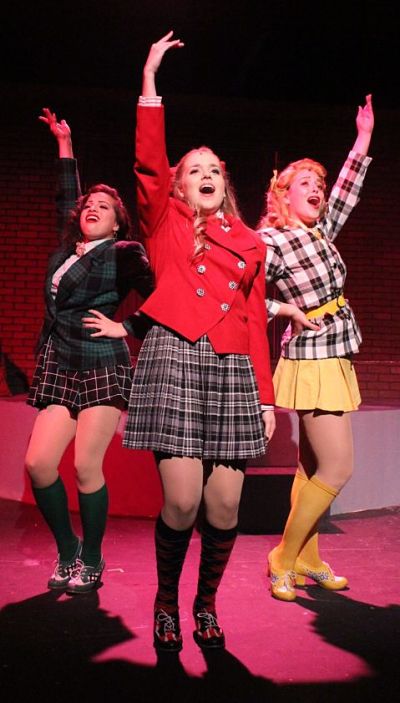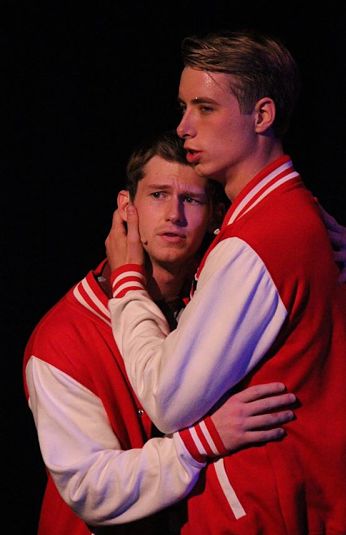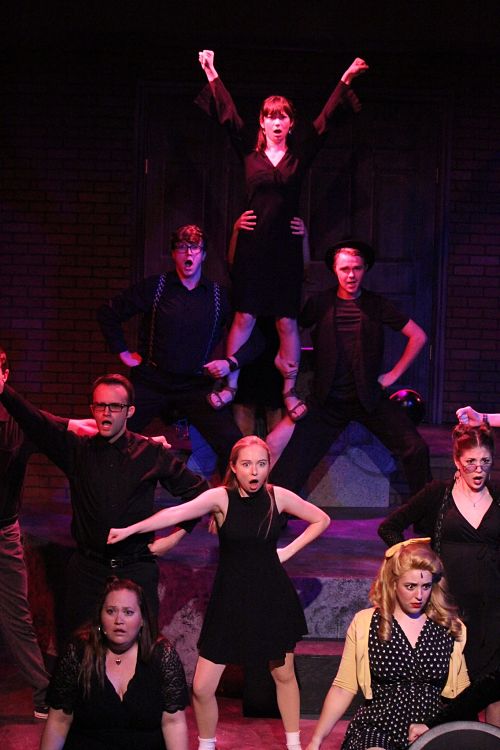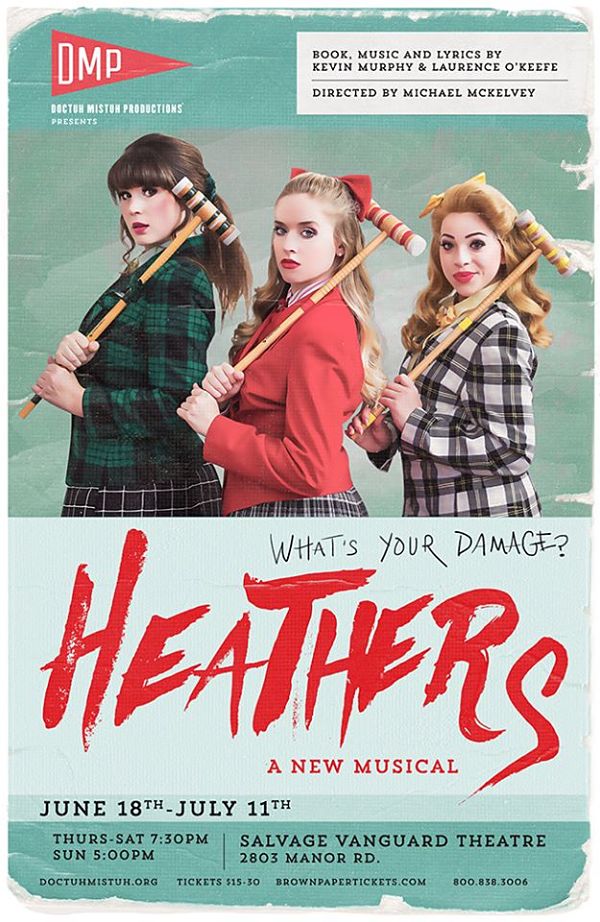Review: Heathers, musical by Doctuh Mistuh Productions
by David Glen Robinson
Heathers is the  musical theatre interpretation of the highly successful 1988 movie of the same name. Doctuh Mistuh Productions prides itself on bringing to Austin plays and productions not commonly produced here, and they win again with Heathers. The stage musical premiered officially in New York in 2014, and this production is certainly its Austin premiere.
musical theatre interpretation of the highly successful 1988 movie of the same name. Doctuh Mistuh Productions prides itself on bringing to Austin plays and productions not commonly produced here, and they win again with Heathers. The stage musical premiered officially in New York in 2014, and this production is certainly its Austin premiere.
The stage musical is if anything darker than the movie, which gained cult status and is still wildly popular among teens and twenty-somethings whose successors continue to discover it twenty-seven years on. The musical’s setting is middle-class Westerburg High School, a murder and suicide high school if ever there was. The titular Heathers are ventriloquized with repartee of profound cynicism. The humorous context is gained by the hard-bitten, knowing lines hissing forth from the mouths of shiny, immaculate teenage girls. The show is clearly a black comedy, perhaps the best in recent memory. Light musical theatre can deal in serious themes of life and death and abuse. Here’s one.
The Doctuh Mistuh production of Heathers is directed by Artistic Director Michael McKelvey with powerful choreography by Madison Piner. She has something for every large and small production number. And the show is large, with 20 songs and at least three reprises. One list of stand-out songs has “Candy Store,” ”Fight for Me” (with its innovative ensemble chorus of “Holy shit!”), “Our Love is God,” “My Dead Gay Son”, “Seventeen,” “Kindergarten Boyfriend,” and “Yo, Girl/Meant to Be Yours.” Your list may vary; this is a strong show musically across the board.
Doctuh Mistuh has cast its net widely for the large cast of Heathers. Several actor/singers have come from the Weitzenhoffer School of Musical Theatre at the University of Oklahoma, including Taylor Bryant, who plays Heather Chandler; Massiani Menas, who plays Heather McNamara; and Gray Randolph, who plays JD. These are all powerful singers who cannot be overwhelmed by a loud and long production number. The same goes for Celeste Castillo, who plays Heather Duke. Aline Mayagoitia, a graduate of McCallum Fine Arts Academy and student at the University of Michigan, plays the central role of Veronica Sawyer and is similarly strong. Another principal, Krystal Newcomer, plays Martha Dunnstock, and gives the powerful solo “Kindergarten Boyfriend.” Oddly, she has no bio in the program.
The large ensemble does a lot of work in every production number, and it has at least three graduates of MacCallum Fine Arts Academy, including stand-out Annamarie Kasper. She is currently a student at the University of Michigan and already an Austin theatre veteran.
The play proceeds lightly into its depths from forged hall passes and back seat near-sex at the cemetery (how symbolic, kids) to full-blown serial murders, suicide attempts, and ghost hauntings (Heather Chandler, returned in her theme red satin night jacket, showing lots of leg). There is young love and a full sex scene, expertly choreographed and well-draped from first to last while the couple sings a love duet. This is R-rated musical theatre without a doubt.

One passage must be described here, and if anyone thinks it is a spoiler, well, let the Cornnuts fall where they may. This reviewer doesn’t know if a playwright or adapter scripted certain scenes creating a metatheatrical device, or if an artistic director or other devised them. But it is true that any theatrical genius occasionally has to do something to refresh the genius reputation and then move on. Here it is: JD’s father, Big Bud Dean, portrayed by Matt Connelly, is a scaly-tailed businessman of abusive reputation and supreme creepiness. When he enters his scenes with JD, Big Bud Dean gives JD’s spoken lines, and JD gives his father’s lines, thus switching the dialogue. The effect is macabre on the surface and even more chilling on a deeper level. These father-son scenes are well done all around. Ultimately, the effects amount to an emotional red herring, but the scenes are the finest within memory of the profound truth that the child is father to the man.
This review was written slightly less than two weeks after the Charleston Immanuel Church shootings. The wound to the heart of all who care is not about to start healing. Inevitably, as after Columbine, Sandy Hook, the Aurora multiplex killings, and the Waco Biker War, leaders will say enough is enough; and many will insist that we must change. But what and where to start? Closer to our milieu, the character John Wilkes Booth in Sondheim’s Assassins says: “Attention must be paid.” One cannot simply mop up the blood and move on. And artistic expressions of violence and hate as in TV shows, films, and musical theatre are dragged in for debate on their propensities to incite what they depict, becoming self-fulfilling prophecies. So is Heathers insight or incitement?

The Random House College Dictionary defines the transitive verb glamorize as: (1) to make glamorous, and (2) to glorify or romanticize. Pardon the classroom teaching during summer vacation, but this is to a point, particularly definition 2. Remember, too, that what we glorify we emulate. What the upper-middle-class teenage Heathers and the violence-prone plebeians around them glamorize is murder, mass-murder, suicide, forcing suicide, and lesser felonies such as aggravated assault, attempted rape, forgery, and fraud. And help me—is underage sex, even if consensual, no longer a crime? The mere immorality of lying is worth mentioning only because if it weren’t for characters lying to others in order to manipulate them, Heathers wouldn’t have much of a plot on which to string its aforementioned felonies.
 Not good. Debates on artistic depictions of abuse and evil will never cease. To cut to the chase, the response anticipated here is that depictions such as those in Heathers are a cautionary tale, a postcard to adults on the realities in high schools, and a mirror held up to society. In opposition to that argument, one can hold that because of the strong layers of glamorizing—glamorous teens, great music, strong hip-hop dance, fighting and gunplay, getting away with sex, getting away with murder—Heathers gives a wink with a twinkle and a roadmap to teens to pursue their glamorized desires (including candy!) with no accompanying roadmap to responsibility. In the case of Heathers I prefer the second view.
Not good. Debates on artistic depictions of abuse and evil will never cease. To cut to the chase, the response anticipated here is that depictions such as those in Heathers are a cautionary tale, a postcard to adults on the realities in high schools, and a mirror held up to society. In opposition to that argument, one can hold that because of the strong layers of glamorizing—glamorous teens, great music, strong hip-hop dance, fighting and gunplay, getting away with sex, getting away with murder—Heathers gives a wink with a twinkle and a roadmap to teens to pursue their glamorized desires (including candy!) with no accompanying roadmap to responsibility. In the case of Heathers I prefer the second view.
It is only fair to mention here one subtext and one underlying theme. The subtext is that parents, teachers, and police have not one clue, no, not one. Parents can’t remember bed check, and police can’t catch a cold or a rolling donut. Adults exist only for comic relief except in the case of JD’s dad. If the adults in Heathers had any credibility, that roadmap to responsibility might be available.
The underlying theme is stated in the subtitle, “What’s your damage?” The characters ask it of each other in various formulations. In the therapy-laden upper-middle class of Westerburg High (and all of North America), all the students can articulate their damage, and it’s a DSM-VI of adolescent morbidity and disorders, right through the character list. JD, the eighties updated-fifties Juvenile Delinquent, is particularly eloquent in articulating his damage—his mother waved goodbye to him as she committed suicide. Elsewhere, there is alcohol abuse, drug abuse, sexual abuse, physical abuse, and mental and emotional abuse. On the whole, the characters struggle for solutions but do not find them. In a depiction of supposed redemption for Veronica, after saving a gymnasium of students at the cost of another life she apologizes, kisses, hugs, and pledges unwavering friendship to one of the characters she had seriously damaged. As redemption, this is shallow and cartoonlike. In reality, Veronica, even at seventeen, would be facing several years’ imprisonment as justice. But the ultimate curse is on everyone, sung in one line in one song that flew by too fast for most to catch: “You can never really leave high school.” You take your damage with you, along with your diploma. One supposes this is why it’s called black comedy.
Still, the incisive list of damages all too common in young people may be sufficient to redeem Heathers. But this is for discerning adults to decide, while watching exquisite staging of song and dance. The show is not for teens and younger kids, despite their rushing to the show.

Haul your damage to Heathers at Salvage Vanguard Theatre on Manor Road, but leave the kids at home. The show runs until July 11, 2015.
Heathers, musical
by book by Laurence O'Keefe and Kevin Murphy and based on the 1988 film Heathers
Doctuh Mistuh Productions
June 18 - July 11, 2015
7:30 p.m. Thursdays - Saturdays. Sunday at 5 p.m.
ADDED PERFORMANCE Sunday, July 5 at 8:30 p.m.
Tickets $15.00-30.00 (Special Double Feature Tickets available below)
& (800) 838-3006
combo ticket with The Rocky Horror Show

